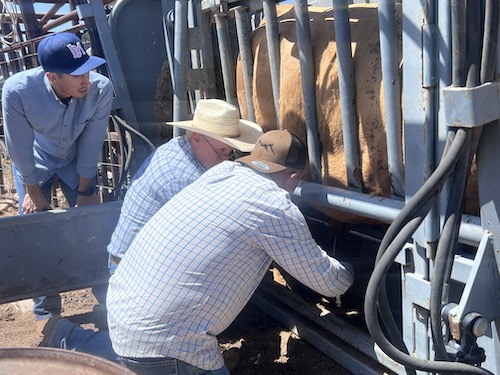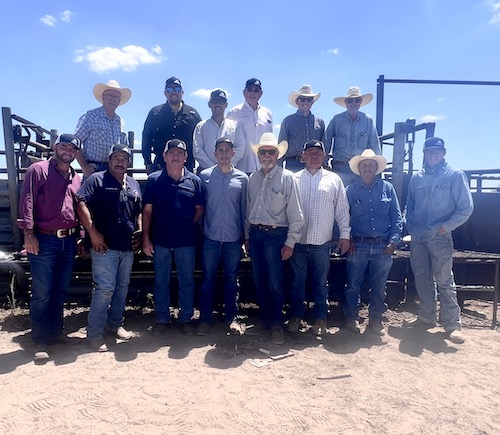 The New Mexico Department of Agriculture, in conjunction with the New Mexico State University Cooperative Extension Service, held a hands-on training exercise July 24 focused on maintaining herd health in cattle in Hachita, New Mexico. The training exercise took place as part of the New Mexico-Sonora Commission’s ongoing Campaign for the Eradication of Bovine Trichomoniasis and Brucellosis in the State of Sonora. NMSU Extension Veterinarian Dr. John Wenzel (center) guides a veterinarian from Sonora, Mexico, in collecting a Trichomoniasis sample from a bull. (Photo courtesy of the New Mexico Department of Agriculture)
The New Mexico Department of Agriculture, in conjunction with the New Mexico State University Cooperative Extension Service, held a hands-on training exercise July 24 focused on maintaining herd health in cattle in Hachita, New Mexico. The training exercise took place as part of the New Mexico-Sonora Commission’s ongoing Campaign for the Eradication of Bovine Trichomoniasis and Brucellosis in the State of Sonora. NMSU Extension Veterinarian Dr. John Wenzel (center) guides a veterinarian from Sonora, Mexico, in collecting a Trichomoniasis sample from a bull. (Photo courtesy of the New Mexico Department of Agriculture)
Hands-on training exercise held in July for veterinarians from Sonora, Mexico
LAS CRUCES, N.M. – The New Mexico Department of Agriculture (NMDA), in conjunction with the New Mexico State University (NMSU) Cooperative Extension Service, held a hands-on training exercise July 24 focused on maintaining herd health in cattle in Hachita, New Mexico. Eight veterinarians from Mexico participated, including the Sonora state veterinarian.
The New Mexico-Sonora Commission was established in 2009 – equivalent to the New Mexico-Chihuahua Commission established in 2003 – under the state of New Mexico’s mandate to increase trade with Mexico. NMDA staff has continued to work with their Mexican counterparts to develop bilateral projects that benefit agricultural industries on both sides of the border and facilitate trade opportunities for New Mexico producers.
The training exercise in July took place as part of the New Mexico-Sonora Commission’s ongoing Campaign for the Eradication of Bovine Trichomoniasis and Brucellosis in the State of Sonora. The campaign was developed to assist Sonora’s veterinarians with addressing the economic impact of these sexually transmitted diseases on cattle producers’ breeding operations.
“This training session offered an excellent opportunity for discussions on diagnostics, disease characteristics and economic impact, as well as hands-on sampling of multiple bulls,” said NMSU Extension Veterinarian Dr. John Wenzel.
Trichomoniasis, commonly referred to as “Trich,” is caused by the organism Tritrichomonas foetus, which is transmitted from cow to cow by infected bulls.
The disease typically causes infertility in cows and can extend the time between births from a single cow. Neither cows nor bulls will exhibit symptoms of illness at any time when they are infected with Trichomoniasis.
The presence of the disease only becomes obvious when there are reproductive problems in a herd, which makes testing the only reliable method for detection. While cows can clear the infection within a few months, bulls are usually permanently infected with Trichomoniasis and are carriers of the disease from one breeding season to another.
Wenzel said that Trichomoniasis testing has greatly reduced the incidence of the disease in New Mexico’s cattle. “For producers, the most important aspect of controlling this disease is timely testing and then removing positive bulls from a herd – this will have a positive effect on producers’ bottom lines.”
Removing the disease from a herd can save the producer approximately $400 for each cow that would have been exposed.
New Mexico Agriculture Secretary Jeff Witte said NMDA staff is excited to continue facilitating interactive training sessions that benefit veterinarians and livestock producers on both sides of the U.S. – Mexico border. “The work of the New Mexico-Sonora Commission has proven to be critical to ensuring the economic viability of the agricultural sector, both domestically and internationally, which is part of our mission at NMDA.”
“Our goal is to have veterinarians and producers come away from this Commission’s workshops with not only technical skills, but also an action plan for the improved health of livestock, that will pave the way for long-term economic stability for industry,” Witte said.
The Sonora livestock industry will be utilizing NMDA’s veterinary diagnostic lab in Albuquerque to conduct all of its Trichomoniasis testing.
 The New Mexico Department of Agriculture, in conjunction with the New Mexico State University Cooperative Extension Service, held a hands-on training exercise July 24 focused on maintaining herd health in cattle in Hachita, New Mexico. The training exercise took place as part of the New Mexico-Sonora Commission’s ongoing Campaign for the Eradication of Bovine Trichomoniasis and Brucellosis in the State of Sonora. Pictured are eight Sonora-based veterinarians, as well as NMDA Deputy Secretary Anthony Parra (front, fourth from right), NMSU Extension Veterinarian Dr. John Wenzel (back, far left) and NMDA Agricultural Production Services Assistant Division Director Marshal Wilson (back, second from right). (Photo courtesy of the New Mexico Department of Agriculture)
The New Mexico Department of Agriculture, in conjunction with the New Mexico State University Cooperative Extension Service, held a hands-on training exercise July 24 focused on maintaining herd health in cattle in Hachita, New Mexico. The training exercise took place as part of the New Mexico-Sonora Commission’s ongoing Campaign for the Eradication of Bovine Trichomoniasis and Brucellosis in the State of Sonora. Pictured are eight Sonora-based veterinarians, as well as NMDA Deputy Secretary Anthony Parra (front, fourth from right), NMSU Extension Veterinarian Dr. John Wenzel (back, far left) and NMDA Agricultural Production Services Assistant Division Director Marshal Wilson (back, second from right). (Photo courtesy of the New Mexico Department of Agriculture)


